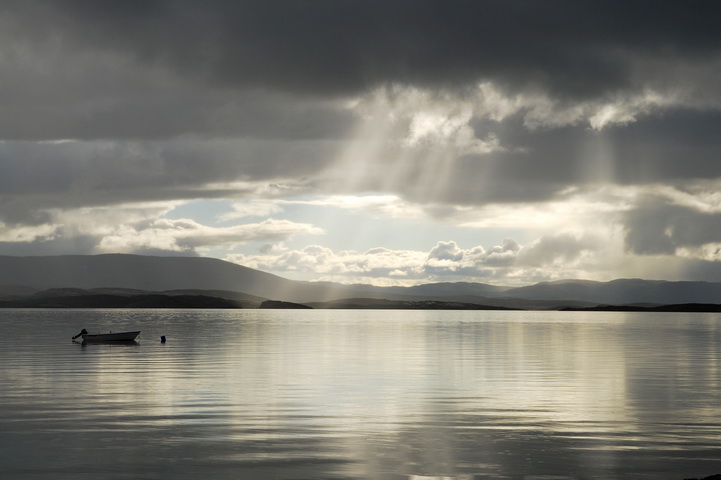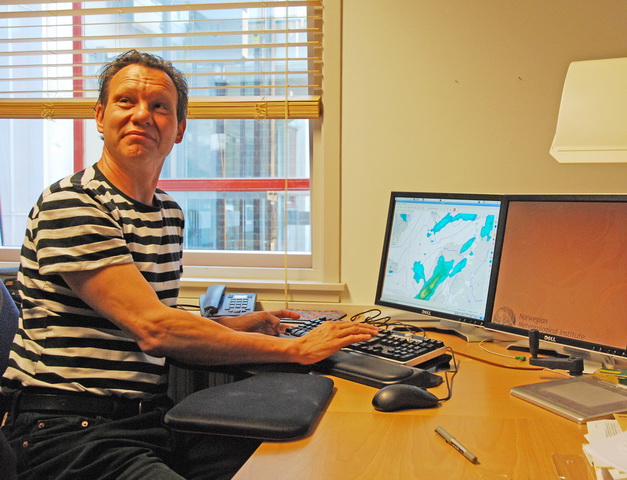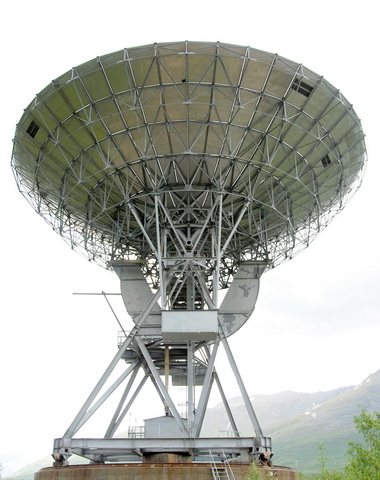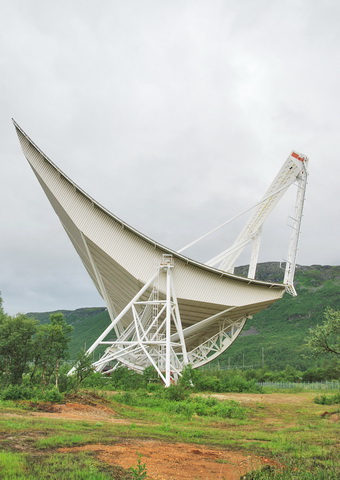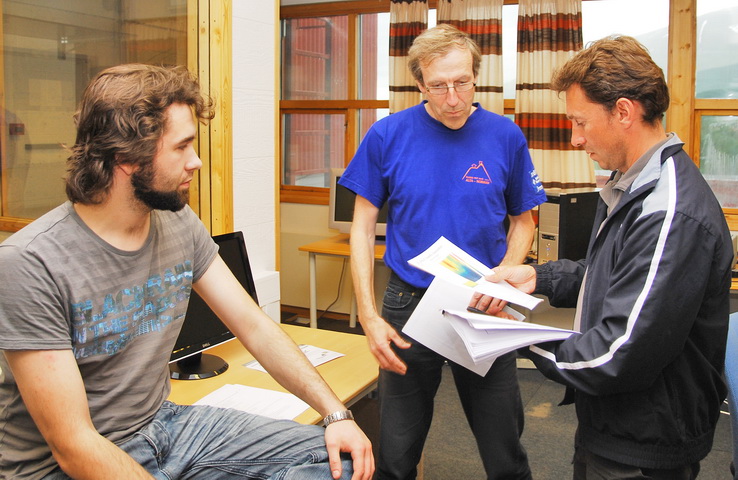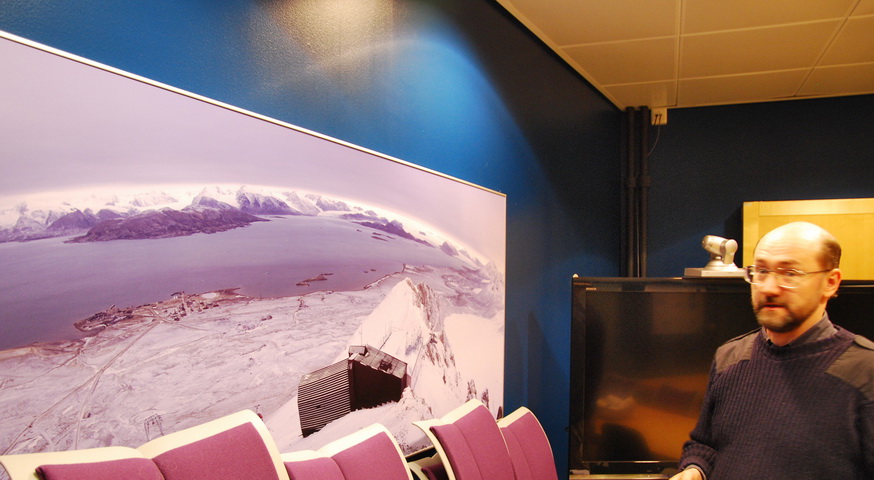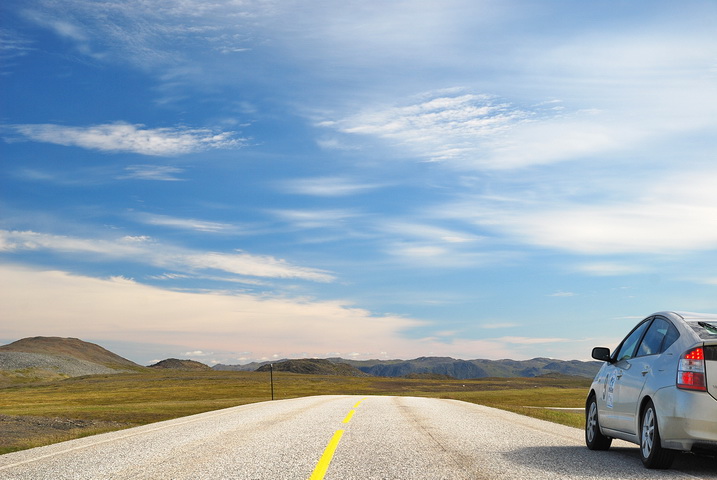THE NORDIC HEAVEN
Note: This report we have prepared as one of the tasks of the Raid Paris – North Cape, 2010.
When you are in the Polar Norway, you see that all ordinary things look differently. Why this northern part of the Scandinavia is different?
To satisfy our curiosity we come in Tromso, beautiful Nordic city, called sometimes “Norwegian Paris”. You may find many interesting attractions in this town, but our interest is the unique scientific and technical center specializing on polar nature, meteorology, oceanography and other fields. Firstly we have visited Norwegian Meteorological Institute.
We are received by Helge Tangen, Regional Director of the institute, and Gjermund Mamen Haugen, the team leader of forecast division. Mr Haugen share with us many interesting facts and details of Nordic nature and every day life. Nice to note that the meteorology is the science which is based on past records, present data and forecasts.
As we are not meteorologist let start with simple things. What is the climate? Simply, it is the average weather or the weather over a long period of time. Therefore, weathermen are collecting continuously records on humidity, temperature, precipitations, wing strength and direction, atmospheric pressure, cloud cover, sunlight intensity and other data, in order to describe this average weather or climate. In Arctic region meteorologists are also attentive to ice and snow cover.
Is the climate changing? Mr. Haugen shows us the plot where the global temperature is increasing last decades. Mr Haugen is joking that in Northern Norway people would appreciate the temperature increase. But in the same time they should tolerate more undesirable insects and the water in lakes and rivers would not be so pure, finally they would prefer to keep things as it is.
During our travel in Northern Scandinavia we can remark very sharp changes in climate in very short distance. Landscapes, temperature and the wind change sometimes in some kilometers substantially. The meteorologist gives us few interesting examples. If your approach Sweden border from Narvik in Kiruna direction, the place close to the small city Riksgransen is the wettest place in Sweden. Only 40 km in east, Abisko region, is the driest in Sweden. In Tromso the lowest temperature recorded by our station is -18 C, less then 100 km in South-East, in Raitijarvi region of Finland, this mark is at -51 C. The list of such curiosities of Scandinavian climate is quite long.
In our Nordic countries the life of many people depends on precise weather forecast
In the end we asked to Mr Haugen few questions which sound little bit provocative. Why we get more precise forecast for Atlantic Pyrenees region from Norwegian meteorological service that from French one, are you using better climate models? Mr. Haugen is smiling: “I have all my respect to my French colleagues, they are highly professional and they use the same models. In Norway, meteorological data are available to everybody for free, here this information is not commercial as compared to others countries outside Scandinavia. In our Nordic countries the life of many people depends on precise weather forecast in very numerous cities and villages, in the sea and in the air.”
– How far your forecast is reliable?
– For 10 days maximum.
– So, you can say nothing about the day of 1st January 2101?
– Nothing at all, even the use of a perfect model would not help you in so far forecasting, the nature is always keeps unexpected factor for us. Little parameter in global climate model you change and you obtain completely different picture. The climate is also the sun activity and the life of the Oceans. It makes climatology very multidisciplinary field.
– It looks some like putting together the terrain, ocean and space climate?
– We may say that, it is a good direction for future research…
When we are talking about space climate, the best place to interview is unique Geophysical Observatory in Ramfjordmoen area, 30 km in South from Tromso. This place is not in tourist guides. It is the scientific institution linked strongly with the Tromso University (the most northern University in Europe). We were kindly received by Stian Grande and Jan Borre Henriksen, members of technical stuff of the Radar station. Normally the station is continuously operating 24/7, but we came in the period of holydays, when radars are stopped for some time, so we could visit these impressive installations. The first one, Ionosonde, is some kind of radar examining the ionized components in upper atmosphere. Originally, this instrument was designed to investigate the capability of the ionosphere to reflect radio waves for long distance communication. Now it is a rare tool for climate research, the case when we talk about the space weather.
Here we can do forecast for Northern Lights.
Mr Grande and Mr Henriksen explain us the importance to be in polar region for such studies, therefore this Nordic center become very attractive for all international scientific societies. They have especially close collaboration with Nagoya University in Japan, Saskatchewan Center in Canada and others institutions over the world. The MF Radar (MF means middle-
frequency) give us the information about winds and turbulences happen 60-120 km from earth surface. It’s just the information which is used to build up the climatology of atmospheric winds, tides, waves and turbulences. It is just beginning. Only emitter in Ramfjordmoen and few other receivers placed in Norway, Sweden and Finland polar region give us a fragmentary picture of the polar sky. This is very precious knowledge for future.
We ask to Stian Grande:
– Normally we can expect such big radars in top of a high mountain and you are completely hided by surrounded hills, what is the reason of your situation?
– There is a reason. Nobody would use cell phones dozens kilometers around because of our radars. Also, any communication station would bring noises for us, so this mountain region offers us very comfortable place were we disturb nobody and nobody disturbs us, sorry, our radars.
After our best wishes we come back to Tromso. In popular tourist attraction center POLARIA we meet Andrey Voronkov, Russian oceanologist working in Norwegian Polar Institute in Tromso. Almost all countries close to polar region, Russia as well, are interested by Polar Institute in Tromso, because from this place they organize expeditions to the wildest regions in far North. During two expeditions to Shpitzbergen Islands Andrey has made studies of leaving entities in the ocean floor. We ask him for some comments on climate and ocean life.
– Shpitzbergen Islands are in vicinity of the ice cover. The local wild life is the most sensitive indicator of the global climate changes.
The places where I provided my observations and collections in the floor were covered with ice as far back as 6 years.
These continuous studies are very valuable complementary information for the global understanding of the climate.
Tromso’s scientists change our look on the sky. After short sunny period the weather is became bad. The sky is covered with heavy clouds. We have left Tromso with the different look at clouds. We are leaving Tromso at this moment and expecting new surprises from the Nordic heavens.
RAID PHOTO PARIS-CAP NORD 2010
Team 9
Alexander Korzhenko, Oleg Mitiukhin, Oksana Mitiukhina
English
Table of Contents: Raid Paris – North Cape 2010 Daily Reports
- 3 July. Paris. The beginning of The Raid
- 3 July. The beginning of The Raid. Part Two
- 4 July. Denmark. Copenhagen
- 4 July. Denmark. Ferry on Svedish side
- 5 July. Sveden. Hamlet and the people
- 6 July. Sveden. Stockholm
- 6 July. Scansen
- 7 July. Helsinki
- 8 July. One hundred thousand of lakes
- 9 July. Finnish lifestyle
- 10 July. Finland. Passing the night on nature
- 11 July. Silent people
- 11 July. Rukka resort
- 12 July. Trip through the natural reserve
- 13 July. Finland
- 14 July. Finland. Further to the North
- 15 July. Norway. Hemningberg
- 16 July. On the place. North Cape
- 16 July. Mageroya
- 17-18 July. Trip to the Soroya Island
- 19-20 July. Tromso
- 21 July. Lofoten Islands
- 22-23 July. Norway. Hobbits and foxes
- 24-25 July. Sveden. Deers and camping
- 26 July. Norway. Trondheim
- 27 July. Norway. Trollstigen
- 28 July. Norway. Bergen
- 29 July. Return
- 30 July. Holland
- 31 July. France. Ending of The Raid
- Paris – North Cape 2010. Results
Ukrainian
Зміст звіту про рейд Париж – Нордкап 2010 року
Підсумки
31 липня 2010. Франція. Фініш рейду
30 липня 2010. Голандія
29 липня 2010. Повернення
28 липня 2010. Норвегія. Берген
27 липня 2010. Норвегія. Дорога тролів
26 июля 2010. Норвегія. Тронхейм
24-25 июля. Швеція. Олені і кемпінг
22-23 липня. Норвегія. Хобіти і лисиці
21 липня. Лофотени
19-20 липня. Тромсо
17-18 липня. Похід на острів Соройя
16 липня. Острів Магероя
16 липня. Приїхали. Мис Нордкап.
15 липня. Норвегія. Хемнінгберг
14 липня. Фінляндія. Далі на північ
13 липня. Фінляндія
12 липня. Похід по заповіднику
11 липня. Курорт Рукка
11 липня. Тихі люди
10 липня. Фінляндія. Ночівля на природі
9 липня. Фінський спосіб життя
8 липня. Сто тисяч озер
7 липня. Хельсінкі
6 липня. Скансен
6 липня. Швеція. Стокгольм
5 липня. Швеція. Село і люди
4 липня. Данія. Паром на шведську сторону
4 липня. Данія. Копенгаген
3 липня. Продовження
3 липня. Париж. Старт рейду

